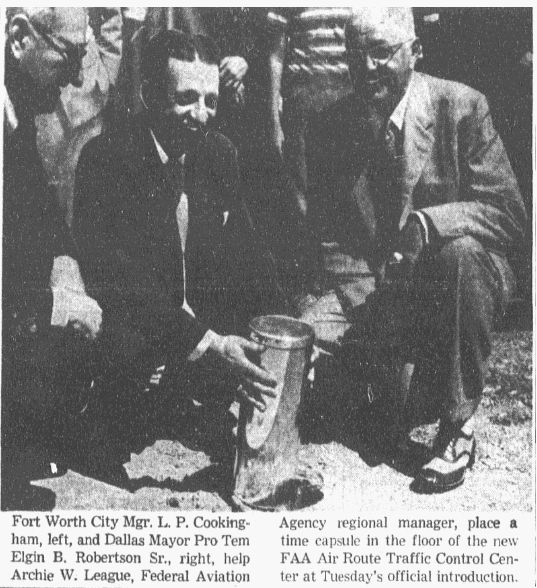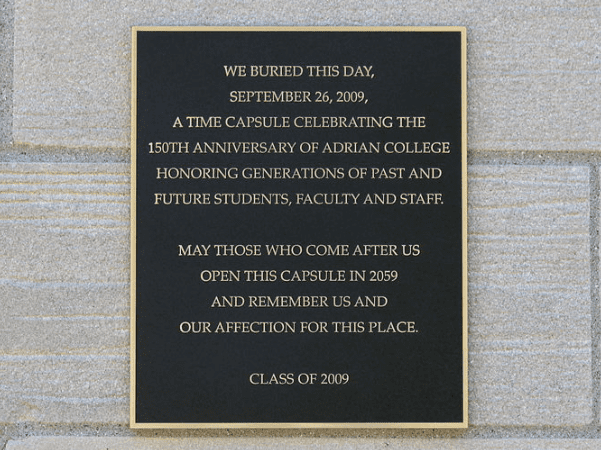Introduction: In this article, Gena Philibert-Ortega writes about the practice of communities burying time capsules for the interest and delight of future generations. Gena is a genealogist and author of the book “From the Family Kitchen.”
Did your school or town ever bury a time capsule? It’s exciting to be a part of something that future people will open. I recently read about the discovery of a time capsule from 1795 placed in the Massachusetts State House by Paul Revere and Samuel Adams. Opening that capsule, more than 220 years old, must have felt like touching history.
Have you ever given much thought to other time capsules that are out there waiting to be discovered? Most are not two centuries old when they are found, but they are important just the same. Have you heard about some of the following time capsules?

In the Year 8113
It’s fun to think about burying a time capsule that your older self will see again – or will be witnessed by your grandchildren. But it’s a little mind boggling to consider a time capsule that will remain sealed for thousands of years. Such is the case for the Crypt of Civilization, closed in 1940 and entombed in a room at Oglethorpe University.
According to a 1940 newspaper article, this time capsule “is the oldest millennial time capsule in conception and the largest in the world.” I think most of us family historians can appreciate the thought behind the Crypt of Civilization. Oglethorpe University president Dr. Thornwall Jacobs believed that the crypt was “our archeological duty… to provide for future historians a thorough and accurate record.”*
Archivist T. K. Peters envisioned King Tut’s tomb when likening the future opening of the Crypt:
“Why, it will be just like our opening an ancient tomb… comparing it to the 1915 [correction: 1922] discovery of the burial place of the Egyptian ruler, King Tut, who had been dead some 4,000 years. The crypt may not be discovered for generations after 8113 because of geographical changes, but after inspecting the remains of the Egyptian tombs, we are sure the crypt will endure indefinitely…”
The Crypt includes a diverse selection of everyday items such as dolls, spark plugs, radios, aluminum foil, and china plates. You can learn more about the Crypt inventory, including photos of the items, at the Oglethorpe Crypt of Civilization website.
Westinghouse World’s Fair Time Capsule
In 1958 a newspaper article commemorated the 20th anniversary of the burial of the 1938 World’s Fair time capsule in Flushing, New York. That article pointed out that even in the 20 years since the capsule was buried, life had changed quite a bit due to major world events like World War II. Items buried in the capsule in 1938 are meant to be opened in 5,000 years and include “35 articles of common use ranging from a slide rule to a woman’s hat.” The 1938 capsule’s exterior is inscribed with this warning:
“Time capsule of Cupaloy, deposited on the site of the New York World’s Fair on September 23, 1938, by the Westinghouse Electric & Manufacturing Company. If anyone should come upon this capsule before the year A.D. 6939 let him not wantonly disturb it, for to do so would be to deprive the people of that era of the legacy here left them. Cherish it therefore in a safe place.”
The World’s Fair isn’t the only fair that included a time capsule. In 1950 the Texas State Fair buried a time capsule on October 22, to be opened in 100 years. In only 33 more years spectators will be able to see what is in that time capsule, which includes “data of historic interest about life in Texas during the first half of the twentieth century.” These items include front pages of newspapers on microfilm, documents, and photographs pertaining to Texas history.
Where Did We Put That Time Capsule?
Not all time capsules are meant to be hidden (but hopefully not forgotten) for thousands of years. Many organizations create their time capsules to be opened in a matter of decades. In this example from the Dallas and Fort Worth area of Texas, a time capsule was buried during the construction of the Air Route Traffic Control Center. That capsule buried in 1960 was to be opened in 2000 and show future people what it was like to be alive just 40 years earlier.
What happened to that time capsule? On 24 June 2000 it was opened at a special event. But just like buried treasure, there is the chance that a time capsule might be forgotten or even lost. Kingman, Kansas, was looking forward to opening their 25-year-old time capsule as part of their 1983 city centennial. They knew about where it should be – under the courthouse lawn – but couldn’t find it. News of the search for the capsule made headlines countrywide.
Did they find the time capsule? A call to the Kingman library didn’t provide an answer, but did reveal that a time capsule buried in the courthouse cornerstone in 1907 was opened in 2008 for the Kingman County Courthouse centennial. That time capsule included newspapers, documents from the local Masonic lodge, materials from local organizations, and various government documents.
Your Time Capsule
Have you helped bury a time capsule? Maybe your family buried one in the yard or hid it in the attic. Does your town have a time capsule that will be opened soon, or perhaps one that has been lost to history? Tell us about it in the comments section below.
Note: An online collection of newspapers, such as GenealogyBank’s Historical Newspaper Archives, is not only a great way to learn about the lives of your ancestors – the old newspaper articles also help you understand American history and the times your ancestors lived in, and the news they talked about and read in their local papers. Have you run across any mention of time capsules in your family history research?
—————————–
* Oglethorpe. Crypt of Civilization. http://crypt.oglethorpe.edu/
